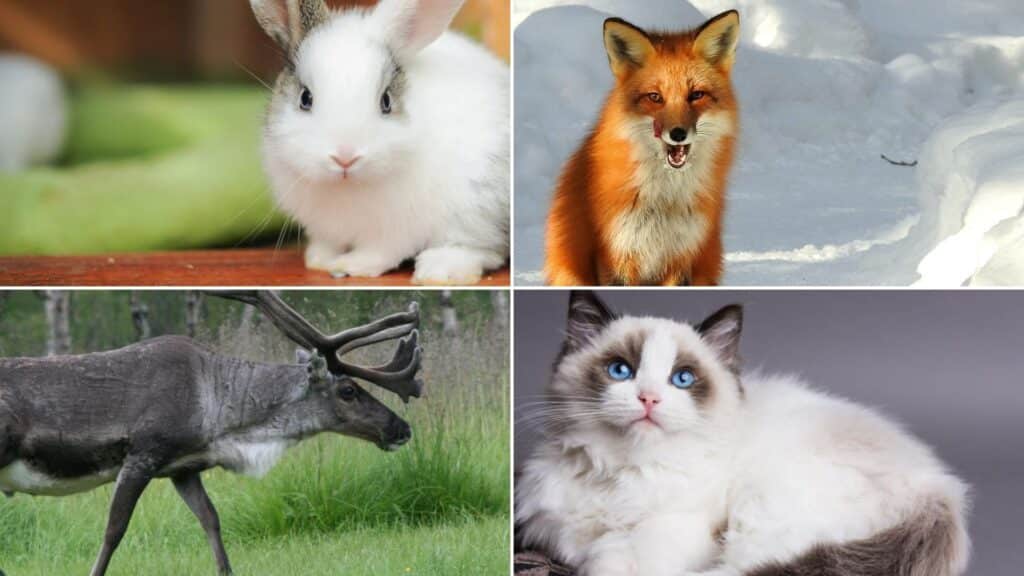Are you ready to explore the wild world of animals with R names? From the towering rhinoceros to the tiny rat, the animal kingdom is teeming with charming creatures whose names start with this letter.
Did you know some animals possess incredible abilities, like the Roadrunner’s lightning-fast speed or the river otter’s playful intelligence?
Perhaps you’re curious about the red panda’s distinctive features or the rock python’s unique adaptations.
This list of 30 animals beginning with R will quench your thirst for knowledge and introduce you to some lesser-known species.
Let’s explore these mesmerizing animals with R names together, whether you’re an animal fan or just curious about wildlife.
Animals That Start With R
Get ready to find a diverse group of creatures whose names begin with the letter R. From familiar favorites to lesser-known species; this section will introduce you to a range of animals that showcase nature’s variety.
We’ll explore mammals, birds, reptiles, and more, each with unique characteristics and behaviors that make them stand out in the animal kingdom.
1. Rabbit

Rabbits are small mammals characterized by their long ears, powerful hind legs, and short fluffy tails.
Depending on the species, they typically measure 20-50 cm (8-20 inches) in length and weigh between 0.4-2 kg (1-4.4 lbs).
Rabbits’ fur can be of various colors, including white, brown, black, or a mixture. They have large, expressive eyes on the sides of their heads, providing a wide vision field.
• Region of Habitat: Worldwide, various environments
• Scientific Name: Oryctolagus cuniculus
• Place of Origin: Europe
• Feeding Habits: Herbivorous, eating grass, leaves, and vegetables
• What Sound They Make: Soft grunts, purrs, and occasionally screams when frightened
Fun Facts: Rabbits have been domesticated since Roman times. Their unique digestive system allows them to extract maximum nutrients from their plant-based diet.
This includes the practice of cecotrophy, where they consume their nutrient-rich droppings to digest them a second time.
Rabbits are also known for their impressive reproductive capabilities, with females capable of producing multiple litters per year.
2. Raccoon
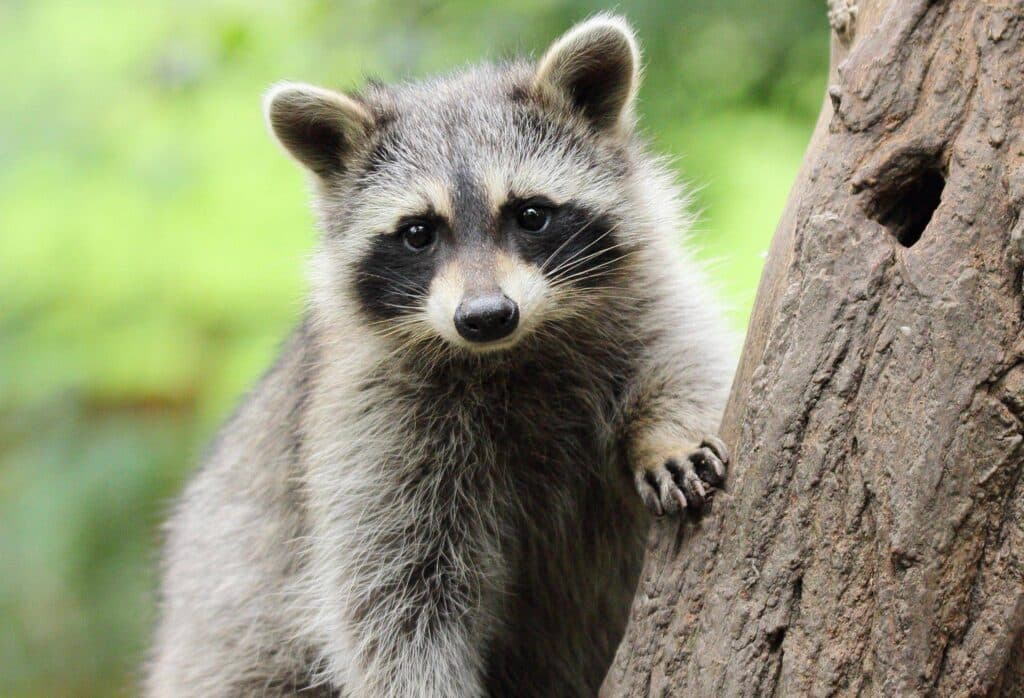
Raccoons are medium-sized mammals known for their distinctive black “mask” across their eyes and ringed tails.
They typically measure 40-70 cm (16-28 inches) in body length, with an additional 20-40 cm (8-16 inches) tail, and weigh between 4-9 kg (9-20 lbs).
Their fur is usually a mixture of gray and brown, with black rings on their bushy tails. Raccoons have dexterous front paws with five toes, which they use with great skill.
• Region of Habitat: North and Central America
• Scientific Name: Procyon lotor
• Place of Origin: North America
• Feeding Habits: Omnivorous, eating fruits, nuts, insects, and small animals
• What Sound They Make: Variety of vocalizations, including chirps, whistles, and growls
Fun Facts: Raccoons are highly intelligent and have excellent problem-solving skills. They are known for their ability to open complex locks and remember solutions to tasks for up to three years.
Their sensitive front paws can identify objects before picking them up, and they often appear to be “washing” their food in water.
However, this behavior is more about gathering sensory information than cleaning.
3. Raccoon Dog
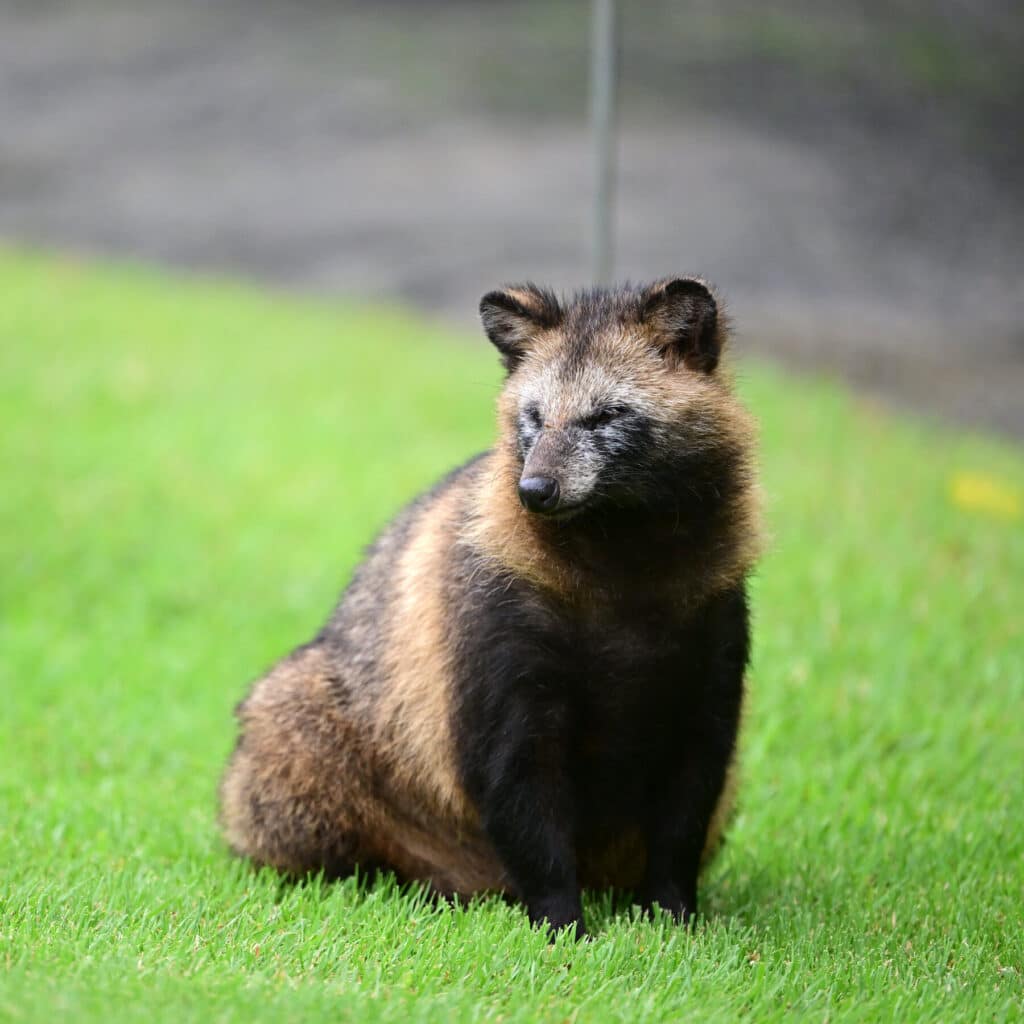
The Raccoon Dog, despite its name, is not closely related to raccoons. It’s a canid native to East Asia.
These animals typically measure 50-70 cm (20-28 inches) in body length, with a tail adding another 15-25 cm (6-10 inches), and weigh between 4-10 kg (9-22 lbs).
They have a stocky body, short legs, and facial markings reminiscent of raccoons. Their thick fur varies in color from yellowish brown to gray.
• Region of Habitat: East Asia, parts of Europe
• Scientific Name: Nyctereutes procyonoides
• Place of Origin: East Asia
• Feeding Habits: Omnivorous, eating small animals, insects, fruits
• What Sound They Make: Barks and whines similar to domestic dogs
Fun Facts: Raccoon Dogs are the only canid species known to hibernate in winter. They are also excellent swimmers and climbers, adaptations that help them thrive in various habitats.
In some parts of Europe, they are considered invasive after being introduced for fur farming.
Unlike most canids, Raccoon Dogs are monogamous, and both parents participate in raising the young.
4. Racer Snake
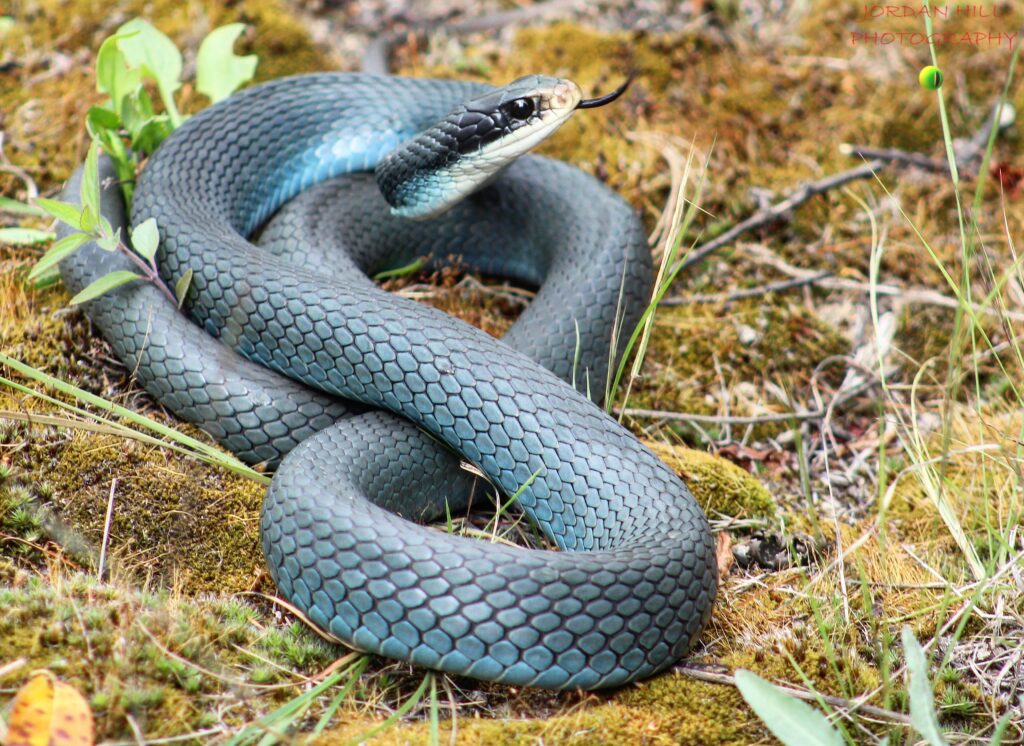
Racer snakes are long, slender snakes known for their speed and agility. They typically grow to lengths of 90-190 cm (35-75 inches) and weigh between 0.5-1.5 kg (1-3 lbs).
Their scales are smooth, giving them a sleek appearance, and their coloration can vary widely depending on the species, ranging from solid black or blue to patterns of brown or olive.
They have large eyes with round pupils, indicating their diurnal nature.
• Region of Habitat: North and Central America
• Scientific Name: Coluber constrictor
• Place of Origin: North America
• Feeding Habits: Carnivorous, eating small mammals, birds, and other reptiles
• What Sound They Make: Generally silent, may hiss when threatened
Fun Facts: Racer snakes do not constrict their prey despite their name. Instead, they rely on their speed to chase down and overpower their victims.
These snakes can move up to 3.5 miles per hour, making them one of the fastest species.
When cornered, Racers may vibrate their tails against dry leaves, mimicking the sound of a rattlesnake as a defensive tactic.
5. Radiated Tortoise
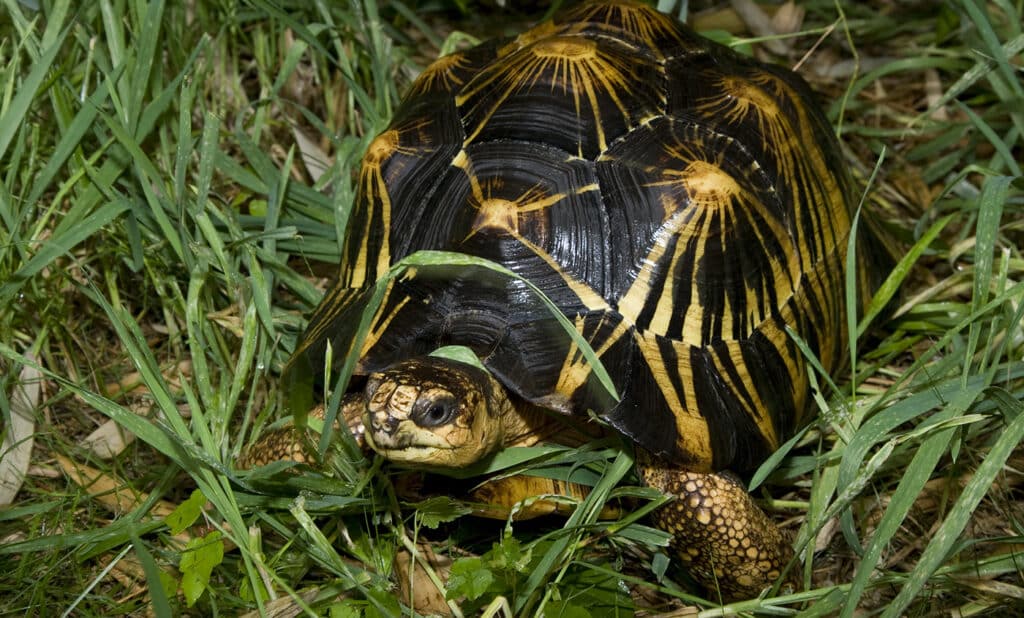
The Radiated Tortoise is a large species of tortoise characterized by its high-domed carapace adorned with intricate yellow line patterns radiating from the center of each scute.
They typically reach lengths of 35-40 cm (14-16 inches) and can weigh up to 20 kg (44 lbs).
Their shell is dark brown or black with a distinctive yellow radiating pattern, while their legs, head, and tail are yellow except for a black cap on the top of their head.
• Region of Habitat: Southern Madagascar
• Scientific Name: Astrochelys radiata
• Place of Origin: Madagascar
• Feeding Habits: Herbivorous, eating grasses, fruits, and succulent plants
• What Sound They Make: Generally silent, may hiss when stressed
Fun Facts: Radiated Tortoises are considered among the most beautiful tortoise species due to their intricate shell patterns.
They are also one of the longest-lived tortoise species, with potential lifespans exceeding 100 years in captivity.
Unfortunately, they are critically endangered in the wild due to habitat loss and illegal collection for the pet trade.
These tortoises uniquely adapt to their arid habitat. They can store water in a special bladder for use during dry periods.
6. Ragdoll Cat

Ragdoll cats are large, semi-longhaired cats known for their docile and affectionate nature. They typically measure 43-53 cm (17-21 inches) in body length and weigh between 4.5-9 kg (10-20 lbs), with males larger than females.
Ragdolls have striking blue eyes and a color point coat, meaning their bodies are lighter in color than their faces, legs, and tails.
Their fur is silky and plush, with little undercoat, which reduces shedding.
• Region of Habitat: Domestic, worldwide
• Scientific Name: Felis catus
• Place of Origin: United States
• Feeding Habits: Carnivorous, commercial cat food and occasional treats
• What Sound They Make: Soft, chirping vocalizations, less vocal than many cat breeds
Fun Facts: Ragdolls get their name from their tendency to relax and go limp when held, much like ragdolls. This breed was developed in the 1960s by a California breeder.
Ragdolls are known for their dog-like personalities, often following their owners from room to room and even coming when called.
Unlike many cats, Ragdolls generally enjoy water and may even join their owners in the shower or bath.
7. Rainbow Boa
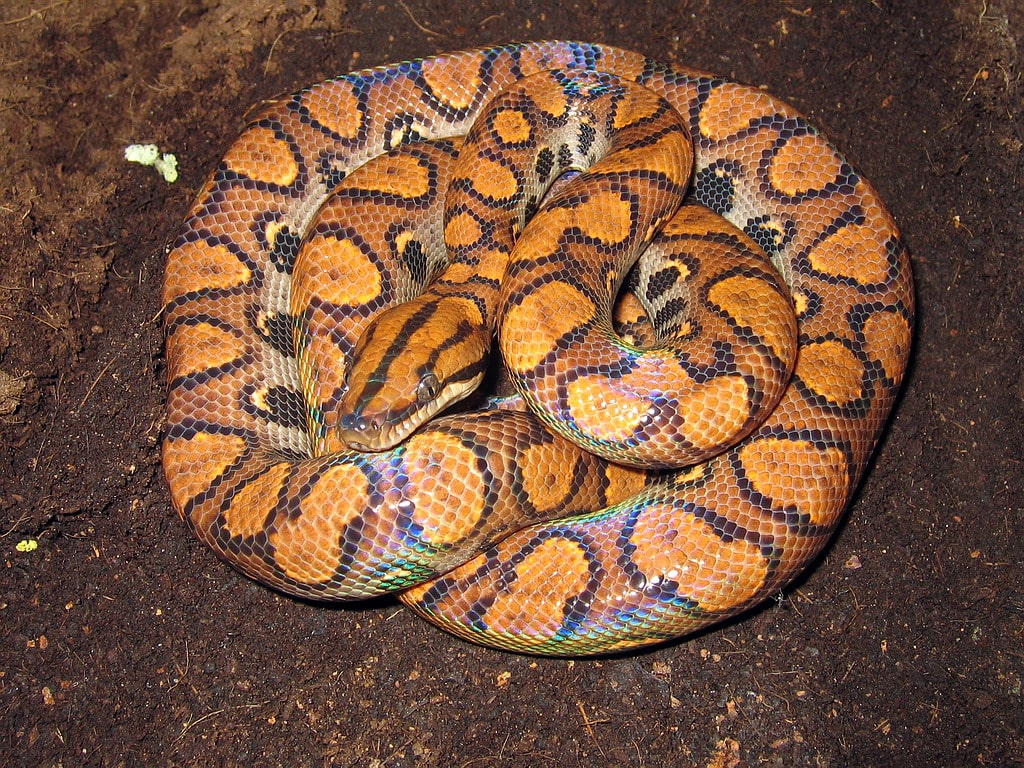
The Rainbow Boa is a non-venomous snake species known for its iridescent scales that create a rainbow-like effect under direct light.
They typically grow to lengths of 1.2-1.8 meters (4-6 feet) and weigh between 1-3 kg (2.2-6.6 lbs).
Their base color is usually brown or reddish-brown, with darker saddled patterns along their back. The Rainbow Boa has a stocky build with a relatively small head compared to its body.
• Region of Habitat: Central and South America
• Scientific Name: Epicrates cenchria
• Place of Origin: Amazon Basin
• Feeding Habits: Carnivorous, eating small mammals and birds
• What Sound They Make: Generally silent, may hiss when threatened
Fun Facts: The Rainbow Boa’s spectacular iridescence is due to microscopic ridges on their scales that refract light, creating a rainbow effect.
This is particularly visible when the snake is in motion. Unlike many other boas, Rainbow Boas are excellent swimmers and are often found near water sources in the wild.
They are also known for their calm temperament, which makes them popular in the exotic pet trade. However, wild populations are declining due to habitat loss and over-collection.
8. Rainbow Shark
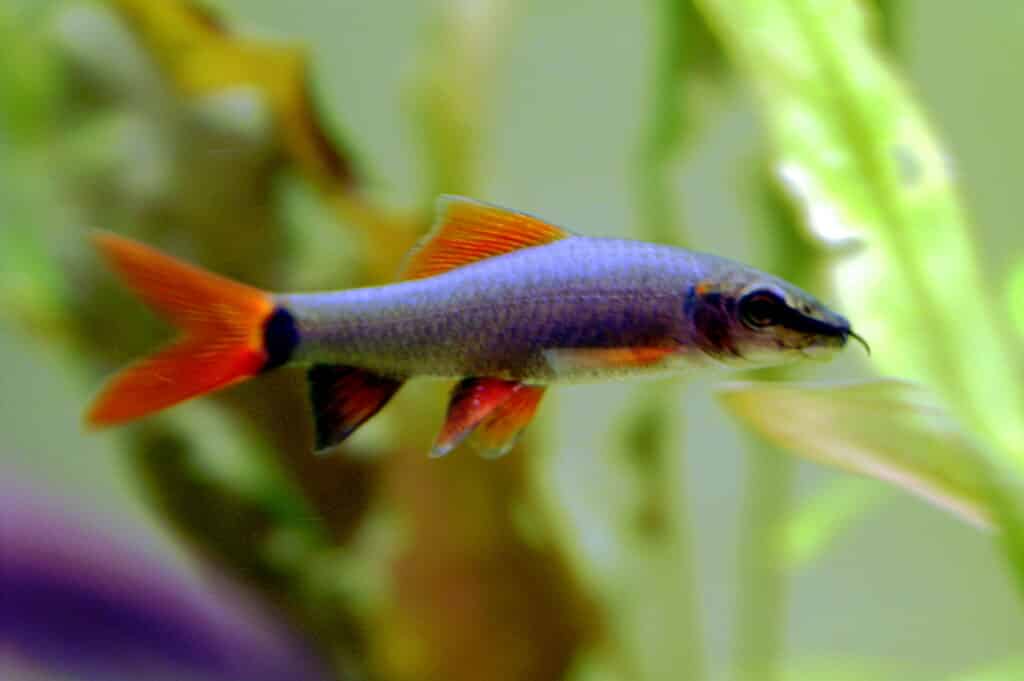
The Rainbow Shark, despite its name, is not a shark but a freshwater fish. They typically grow to lengths of 15-20 cm (6-8 inches) and weigh around 50-100 grams (1.8-3.5 oz).
Their body is torpedo-shaped and covered in dark gray or black scales, with bright red fins that give them their “rainbow” name.
They have a distinctive forked tail and a small mouth with two pairs of barbels.
• Region of Habitat: Southeast Asia, particularly Thailand and Cambodia
• Scientific Name: Epalzeorhynchos frenatum
• Place of Origin: Chao Phraya and Mekong basins
• Feeding Habits: Omnivorous, eating algae, small invertebrates, and plant matter
• What Sound They Make: Silent, like most fish
Fun Facts: Rainbow Sharks are not true sharks but are named for their shark-like body shape and behavior.
In the aquarium trade, there’s an albino variant that is particularly popular due to its striking white body and red fins. These fish are known for their territorial behavior, especially as they mature, and can be aggressive towards their species.
Interestingly, Rainbow Sharks exhibit a symbiotic relationship with certain species of river prawns in the wild.
9. Rat
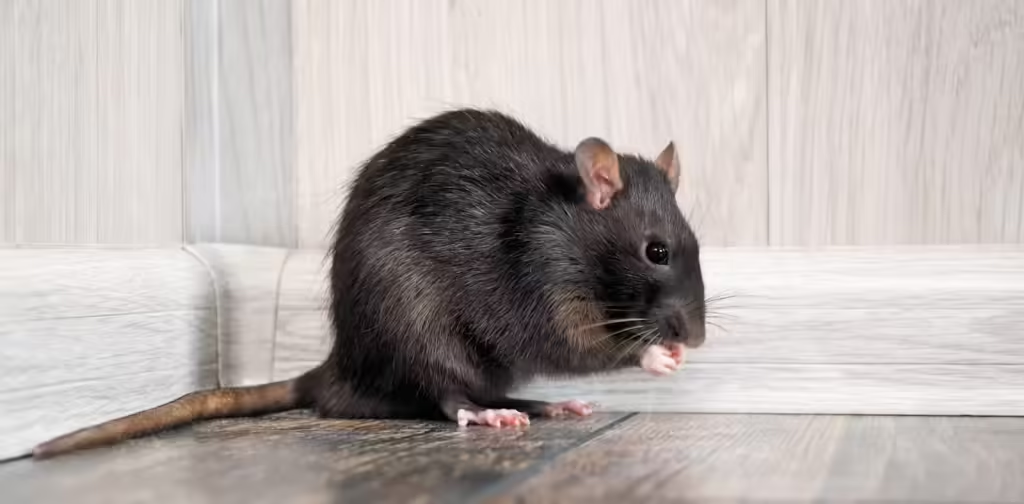
Rats are medium-sized rodents characterized by their long tails, pointed snouts, and relatively large ears.
They typically measure 20-30 cm (8-12 inches) in body length, with tails of similar size, and weigh between 200-500 grams (7-18 oz), depending on the species.
Rats’ fur can be various shades of brown, gray, or black. They have sharp incisors and strong feet with long toes that continuously grow.
• Region of Habitat: Worldwide
• Scientific Name: Rattus (genus)
• Place of Origin: Asia
• Feeding Habits: Omnivorous, eating almost anything
• What Sound They Make: Squeaks, chirps, and ultrasonic vocalizations
Fun Facts: Rats are highly intelligent animals with excellent problem-solving skills. They can learn complex tasks and have demonstrated empathy towards other distressed rats.
Contrary to popular belief, rats are very clean animals and groom themselves frequently.
Their teeth are harder than iron and can gnaw through many materials, including concrete and steel. In some cultures, rats are considered lucky or sacred; in others, they’re seen as pests.
10. Rattlesnake
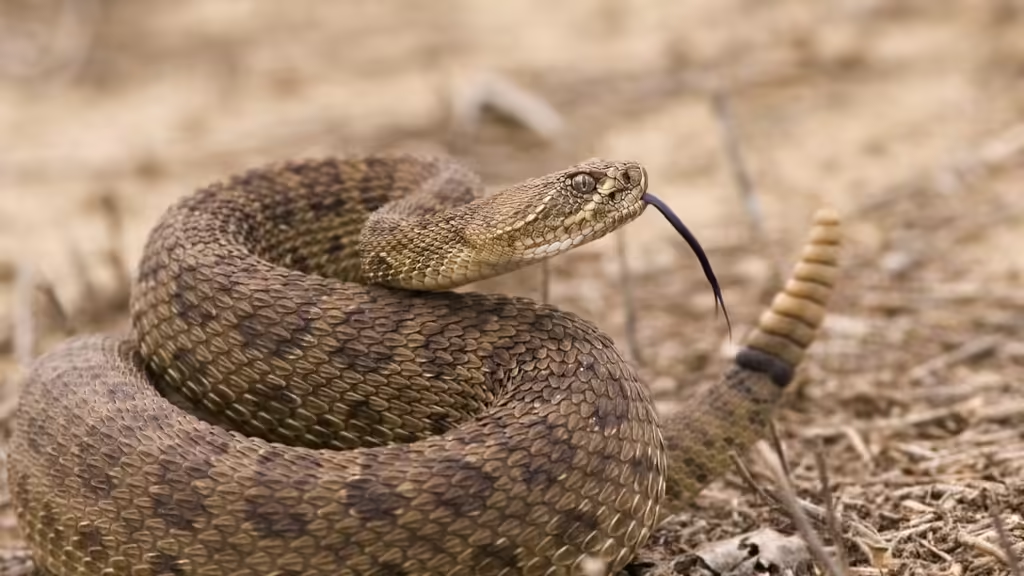
Rattlesnakes are venomous pit vipers known for the distinctive rattle at the end of their tails. They vary greatly in size depending on the species but typically range from 0.5-2 meters (1.6-6.6 feet) in length and can weigh between 1-6 kg (2.2-13.2 lbs).
Their bodies are covered in keeled scales, and their coloration often includes patterns of diamonds, rhombuses, or hexagons that provide camouflage.
Rattlesnakes have heat-sensing pits between their eyes and nostrils, allowing them to detect warm-blooded prey.
• Region of Habitat: North and South America
• Scientific Name: Crotalus (genus)
• Place of Origin: Americas
• Feeding Habits: Carnivorous, primarily eating small mammals and birds
• What Sound They Make: Distinctive rattling sound from the tail, hisses when threatened
Fun Facts: The rattlesnake’s famous rattle is made of interlocking segments of keratin, the same protein found in human fingernails.
A new segment is added each time the snake sheds its skin. Contrary to popular belief, you can’t determine a rattlesnake’s age by counting these segments as they break off over time.
Rattlesnakes are ovoviviparous, meaning the eggs hatch inside the mother’s body, and she gives birth to live young.
These snakes play a crucial role in controlling rodent populations in their ecosystems.
11. Red Fox
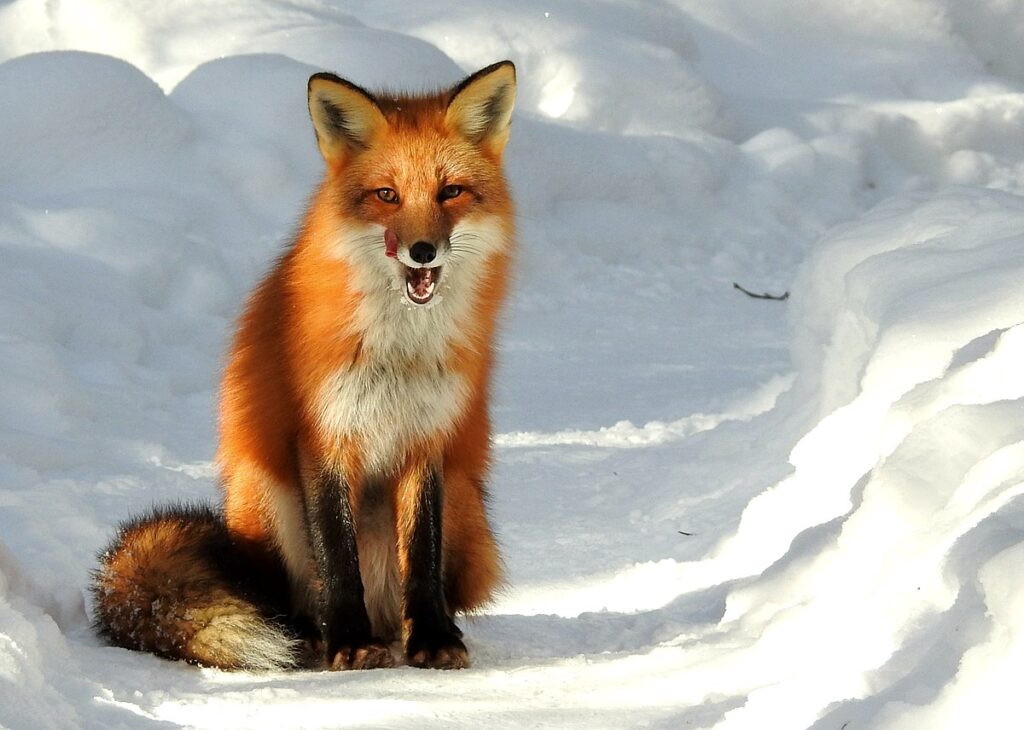
The Red Fox is a small to medium-sized canid known for its reddish-orange fur, white-tipped bushy tail, and black ear tips and legs.
They typically measure 45-90 cm (18-35 inches) in body length, with an additional 30-55 cm (12-22 inches) tail, and weigh between 3-14 kg (6.6-31 lbs).
Their fur can vary from light yellowish to deep reddish-brown, with the underside usually lighter. Red Foxes have elongated snouts and large, pointed ears.
• Region of Habitat: Northern Hemisphere and Australia
• Scientific Name: Vulpes vulpes
• Place of Origin: Eurasia
• Feeding Habits: Omnivorous, eating small mammals, birds, fruits, and insects
• What Sound They Make: Various vocalizations, including barks, screams, and a distinctive “wow-wow-wow” sound
Fun Facts: Red Foxes are the most widely distributed carnivores in the world. They are found throughout the entire Northern Hemisphere and have been introduced to Australia.
They are highly adaptable and can thrive in urban environments and wilderness. Red Foxes have excellent hearing and can detect a mouse squeaking from about 150 feet away.
They are also known for their intelligence and have been observed using tools in problem-solving situations.
In some cultures, foxes are associated with cunning and trickery in folklore and mythology.
12. Red Panda
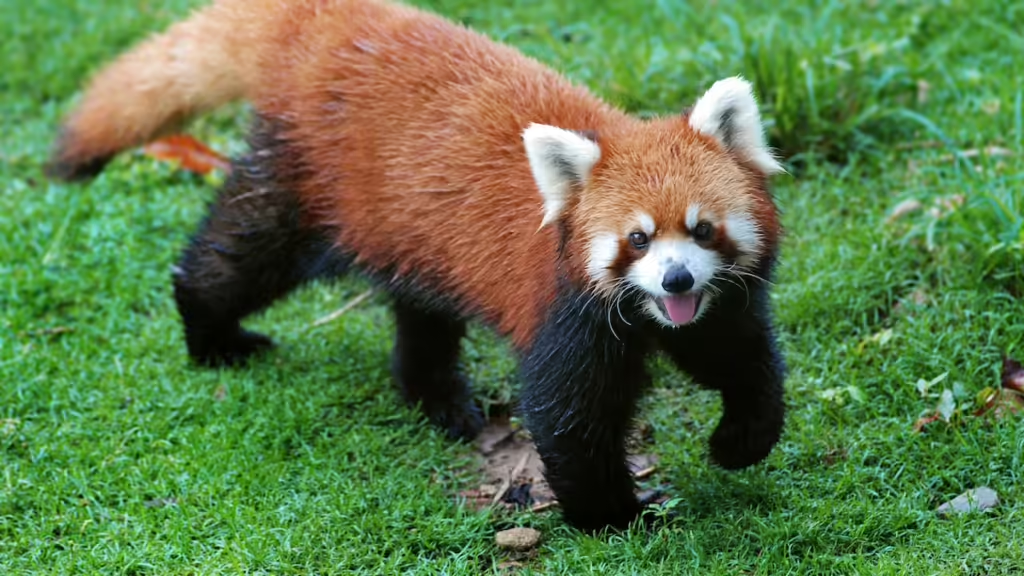
The Red Panda is a small mammal with reddish-brown fur, a long, bushy tail with rings, and a white face with tear markings.
They typically measure 50-65 cm (20-26 inches) in body length, with an additional 30-50 cm (12-20 inches) tail, and weigh between 3-6 kg (6.6-13.2 lbs).
Their thick and soft fur provides insulation in their cool mountain habitats. Red Pandas have semi-retractable claws and a false thumb, adaptations that help them easily climb trees.
• Region of Habitat: Eastern Himalayas and southwestern China
• Scientific Name: Ailurus fulgens
• Place of Origin: Asia
• Feeding Habits: Herbivorous, primarily eating bamboo leaves and shoots
• What Sound They Make: Various vocalizations, including squeaks, twitters, and huff-quack sounds
Fun Facts: Despite their name and appearance, Red Pandas are not closely related to Giant Pandas. They are the only living member of their family, Ailuridae.
Red Pandas are excellent climbers and spend much of their time in trees. They have a low metabolic rate and can lower it even further in colder weather to conserve energy.
Like Giant Pandas, they have a special bone in their wrists that functions as a sixth digit or “false thumb,” which helps them grasp bamboo stems.
13. Red Squirrel
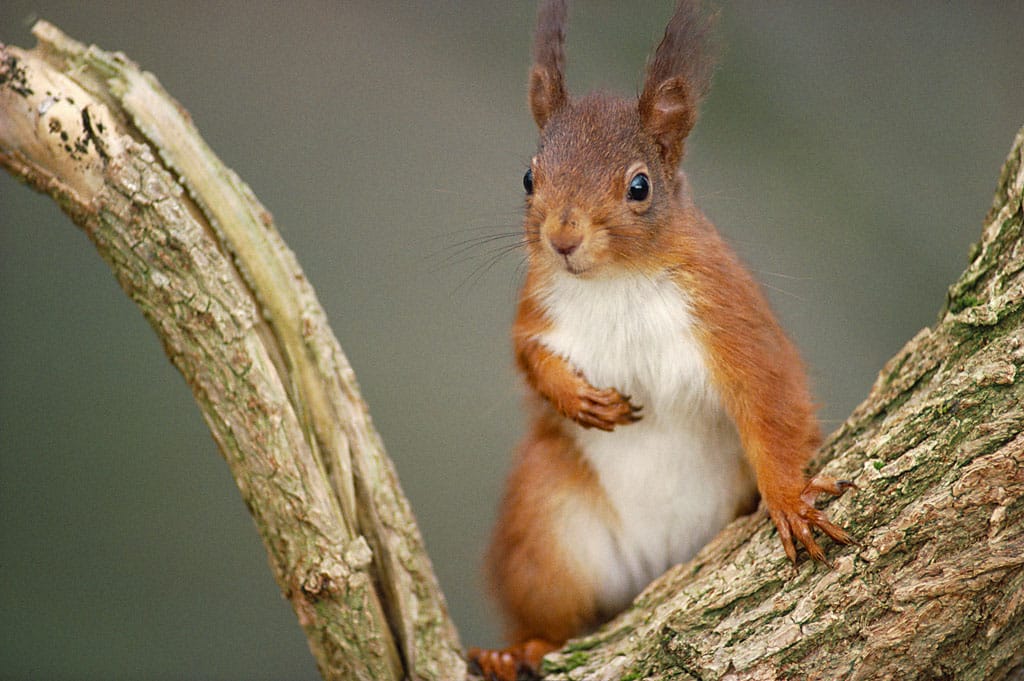
The Red Squirrel is a small arboreal rodent known for its reddish-brown fur and distinctive ear tufts.
It typically measures 18-24 cm (7-9 inches) in body length, with an additional 14-20 cm (5.5-8 inches) bushy tail, and weighs between 250-340 grams (8.8-12 oz).
Their fur color can vary from bright reddish-brown to darker shades, often with a white underside. Red Squirrels have large eyes and sharp claws that aid in climbing and foraging.
• Region of Habitat: Eurasia and North America
• Scientific Name: Sciurus vulgaris (Eurasian), Tamiasciurus hudsonicus (American)
• Place of Origin: Northern forests of Eurasia and North America
• Feeding Habits: Omnivorous, primarily eating seeds, nuts, fungi, and occasionally insects
• What Sound They Make: Various vocalizations, including chucking, trilling, and alarm calls
Fun Facts: Red Squirrels are known for their excellent memory, which allows them to relocate food stores they’ve hidden months earlier.
They are territorial animals and will fiercely defend their territory from other squirrels.
In the UK, native Red Squirrels are threatened by the introduced Eastern Gray Squirrel.
Red Squirrels do not hibernate but are active year-round, though they may spend more time in their dreys (nests) during harsh weather. Their ear tufts grow longer in winter, providing additional insulation.
14. Red Wolf
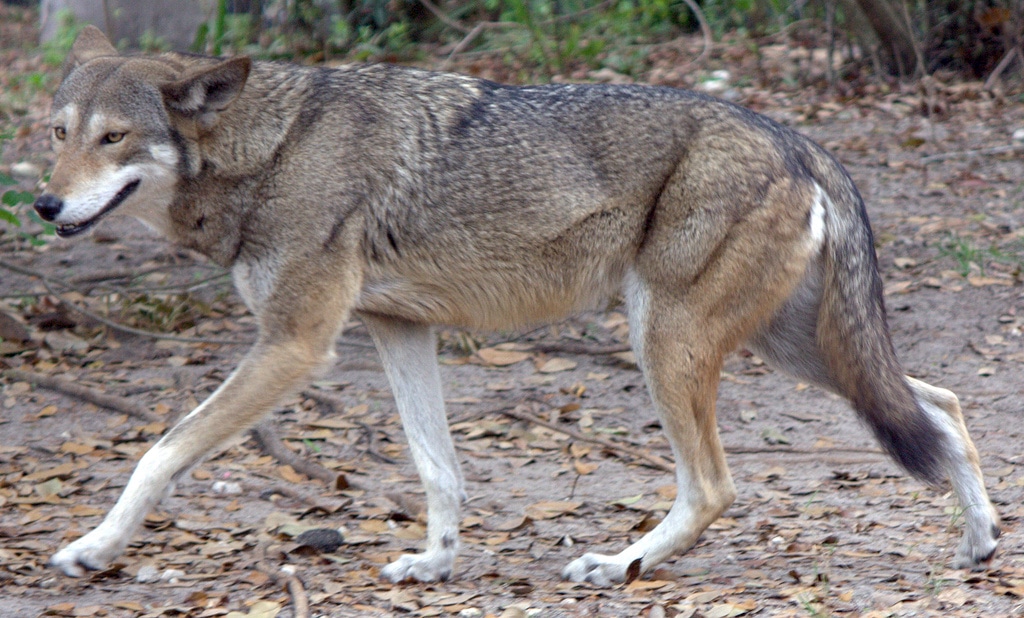
The Red Wolf is a canid species that is intermediate in size between the coyote and gray wolf.
They typically measure 100-130 cm (39-51 inches) in body length, with an additional 30-40 cm (12-16 inches) tail, and weigh between 20-35 kg (44-77 lbs).
Their fur is a mixture of cinnamon, tawny, and gray, often with black along the back. Red Wolves have long legs, large ears, and a broad muzzle, giving them a distinctive appearance.
• Region of Habitat: Southeastern United States (historically)
• Scientific Name: Canis rufus
• Place of Origin: North America
• Feeding Habits: Carnivorous, eating small to medium-sized mammals
• What Sound They Make: Howls, barks, and whines similar to other wolves
Fun Facts: Red Wolves are one of the world’s most endangered canids, with only about 20 individuals estimated to remain in the wild as of 2021.
Red wolves were declared extinct in the wild in 1980 but were reintroduced through captive breeding programs. They are known for their shy nature and tend to avoid humans. Unlike gray wolves, they often hunt alone or in pairs rather than in large packs.
Their diet primarily consists of deer, raccoons, and small rodents, which is crucial in controlling prey populations in their ecosystem.
15. Red-Bellied Black Snake
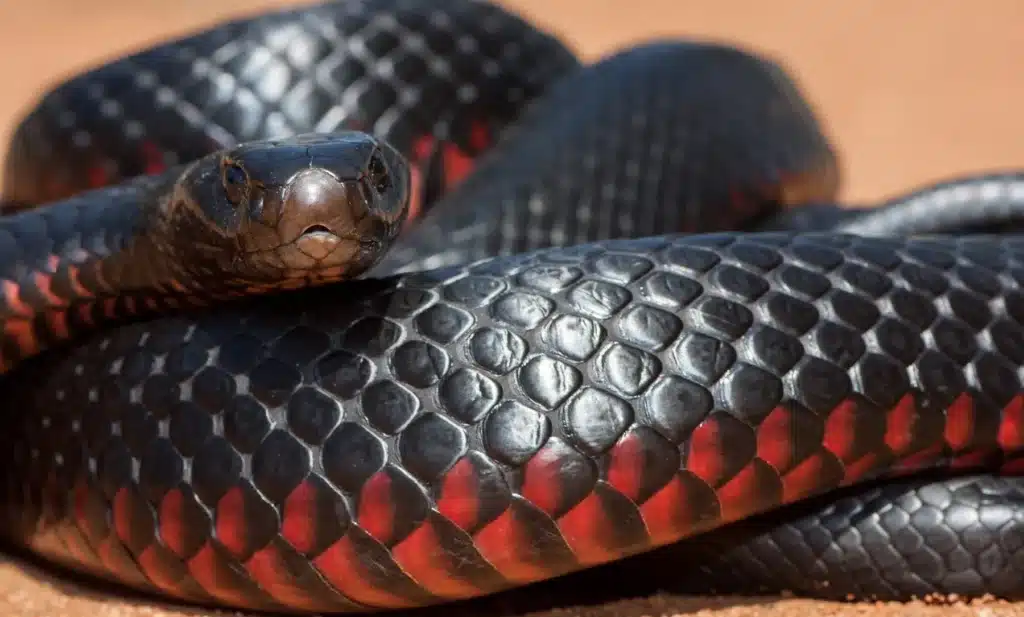
The Red-Bellied Black Snake is a venomous snake species known for its glossy black dorsal and bright red or pink ventral scales.
They typically grow to lengths of 1.5-2 meters (5-6.5 feet) and can weigh up to 2 kg (4.4 lbs). Their head is relatively small and difficult to distinguish from the neck.
Despite their venomous nature, they have a relatively peaceful temperament.
• Region of Habitat: Eastern Australia
• Scientific Name: Pseudechis porphyriacus
• Place of Origin: Australia
• Feeding Habits: Carnivorous, primarily eating frogs and small reptiles
• What Sound They Make: Generally silent, may hiss when threatened
Fun Facts: Despite being venomous, Red-Bellied Black Snakes are considered one of Australia’s least dangerous elapid snakes due to their calm nature and unwillingness to bite.
They are excellent swimmers and are often found near water sources. These snakes play a crucial role in their ecosystem by controlling frog and lizard populations.
Interestingly, they are immune to the venom of other Australian elapid snakes, which sometimes form part of their diet.
16. Red-Eyed Tree Frog
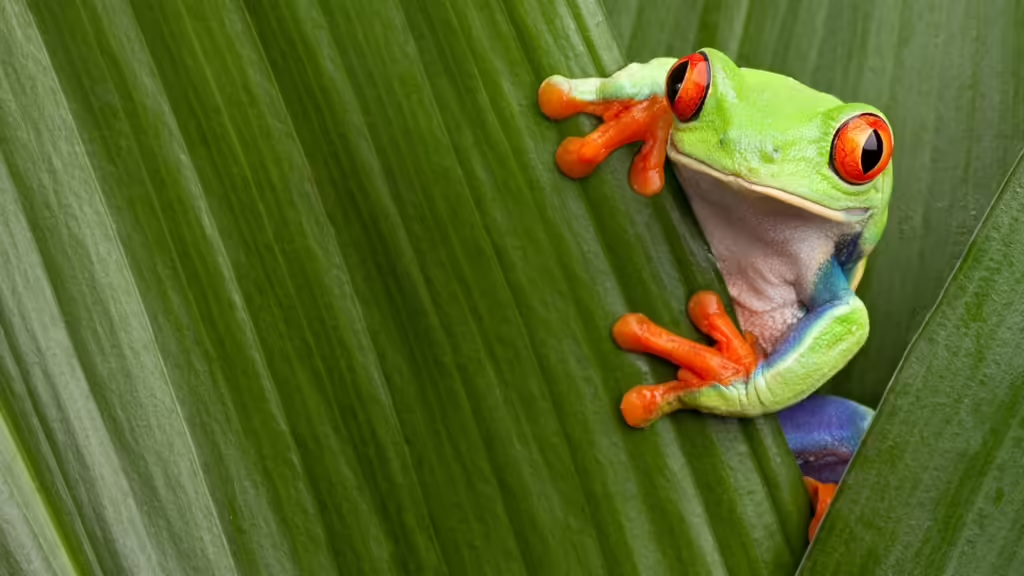
The Red-Eyed Tree Frog is a small arboreal frog known for its vibrant coloration. It typically measures 5-7 cm (2-3 inches) in length and weighs about 6-15 grams (0.2-0.5 oz).
Their body is primarily bright green with blue and yellow striping on the sides.
Their most distinctive feature is their large, bulging red eyes. Their specially adapted toe pads allow them to climb and cling to surfaces with ease.
• Region of Habitat: Neotropical rainforests of Central America
• Scientific Name: Agalychnis callidryas
• Place of Origin: Central America
• Feeding Habits: Carnivorous, eating insects and small invertebrates
• What Sound They Make: Soft croaking sounds, particularly during mating season
Fun Facts: Red-Eyed Tree Frogs are not poisonous despite their bright colors. Their vivid coloration is an example of startle coloration – when threatened, they suddenly reveal their glowing eyes and orange feet, which may momentarily confuse predators.
These frogs are excellent jumpers and can leap up to 50 times their length.
During the day, they sleep on the underside of leaves with their eyes closed and limbs tucked in, effectively camouflaging themselves.
17. Reindeer
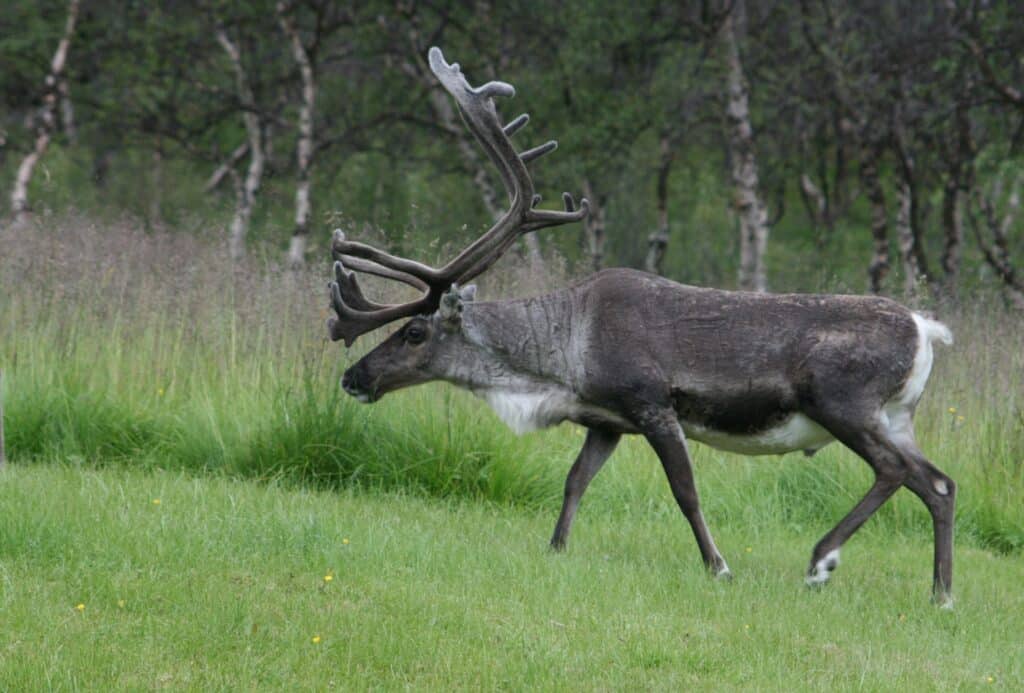
Reindeer, or caribou in North America, are large deer species adapted to cold climates. They typically stand 80-150 cm (31-59 inches) at the shoulder, measure 120-210 cm (47-83 inches) in body length, and weigh between 80-180 kg (176-397 lbs).
Both males and females grow antlers, which is unique among deer species. Their coat is thick and varies in color from dark brown to white, often changing seasonally.
• Region of Habitat: Arctic and Subarctic regions of North America, Europe, and Asia
• Scientific Name: Rangifer tarandus
• Place of Origin: Northern Holarctic region
• Feeding Habits: Herbivorous, eating lichens, mosses, and plants
• What Sound They Make: Various vocalizations, including grunts and snorts
Fun Facts: Reindeer are the only deer species where males and females grow antlers.
Reindeer can see ultraviolet light, which helps them spot predators and food in the snow-covered Arctic.
They are excellent swimmers and have been known to migrate up to 3,000 miles annually, making them the land mammal with the longest known migration.
18. Rhesus Macaque
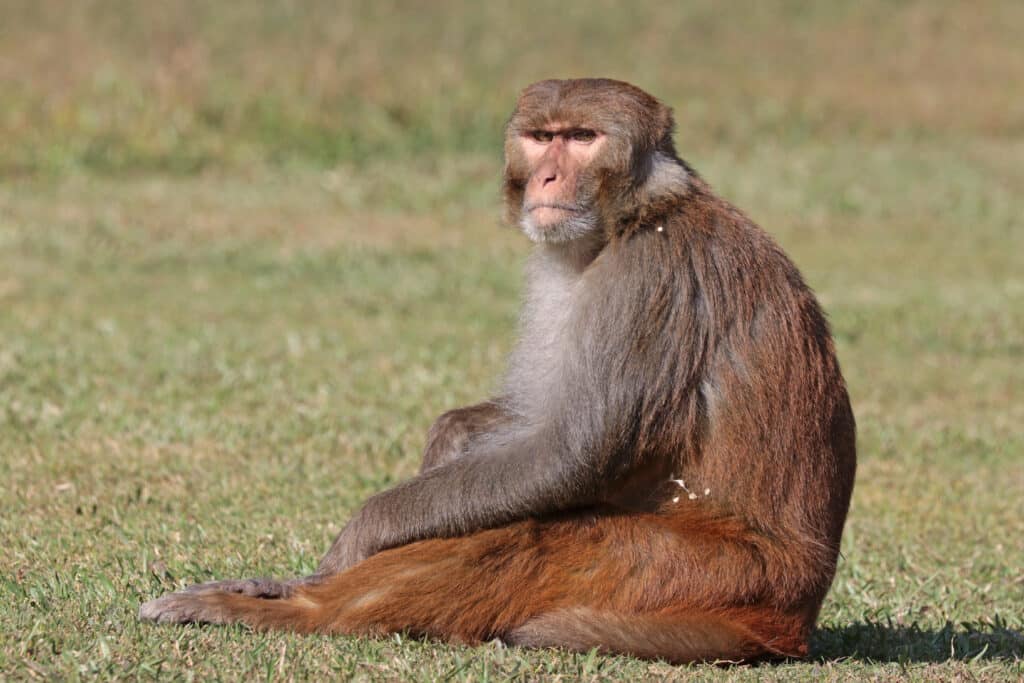
The Rhesus Macaque is a small to medium-sized Old World monkey. It typically measures 47-53 cm (19-21 inches) in body length, with an additional 20-30 cm (8-12 inches) tail, and weighs between 5-8 kg (11-18 lbs) for males and 3-5 kg (7-11 lbs) for females.
Their fur is generally brown or grey, and their pink faces often become redder when the animal is excited.
They have relatively short tails and powerful limbs adapted for terrestrial and arboreal locomotion.
• Region of Habitat: South, Central, and Southeast Asia
• Scientific Name: Macaca mulatta
• Place of Origin: Asia
• Feeding Habits: Omnivorous, eating fruits, seeds, roots, insects, and small animals
• What Sound They Make: Various vocalizations, including grunts, barks, and screams
Fun Facts: Rhesus Macaques are one of the most widely studied primate species due to their similarities to humans.
They played a crucial role in developing the Rh factor blood group system named after them.
These monkeys are excellent swimmers and have been observed swimming over a kilometer from shore.
They are considered sacred in some parts of India and can often live alongside humans in urban areas.
19. Rhino Beetle
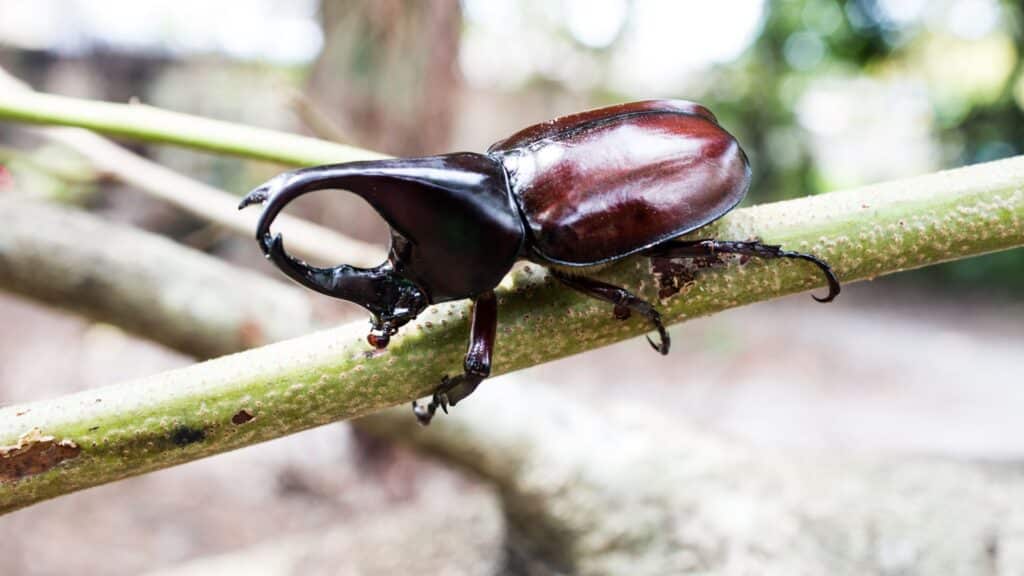
Rhino Beetles are large beetles known for the horn-like projections on the males’ heads. They typically measure 30-150 mm (1.2-6 inches) in length, depending on the species, making them some of the largest beetles in the world.
Their bodies are strong and covered in a hard exoskeleton, usually dark brown or black. Males use distinctive horns to fight for mates, and they can be up to one-third of the beetle’s total length.
• Region of Habitat: Tropical and subtropical regions worldwide
• Scientific Name: Dynastinae (subfamily)
• Place of Origin: Various, depending on species
• Feeding Habits: Herbivorous, eating rotting fruit, tree sap, and plant matter
• What Sound They Make: Mostly silent, may produce a hissing sound when disturbed
Fun Facts: Rhino Beetles are among the strongest animals on Earth relative to their size. They can lift up to 850 times their body weight.
Despite their formidable appearance, they are harmless to humans and do not bite or sting. The larvae of Rhino Beetles can take several years to develop into adults, during which time they live in decaying wood or soil.
In some cultures, particularly in parts of Asia, Rhino Beetles are kept as pets or used in beetle-fighting contests.
20. Rhinoceros
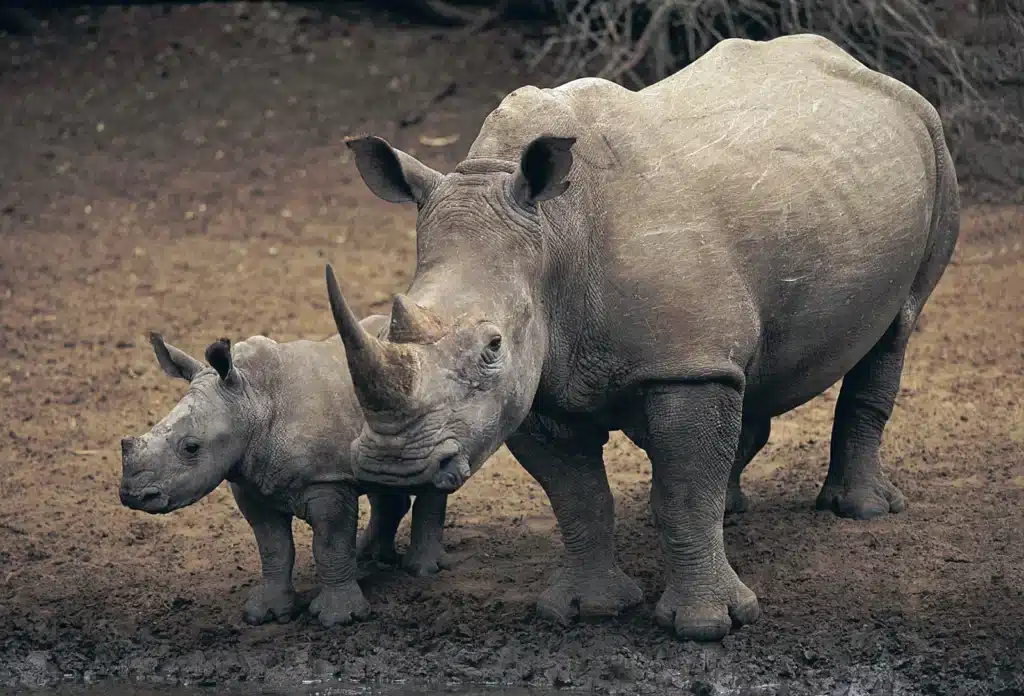
Rhinoceroses are large, herbivorous mammals characterized by their thick skin and one or two horns on their snouts.
Depending on the species, they can measure 3-5 meters (10-16 feet) in length, stand 1.5-1.8 meters (5-6 feet) at the shoulder, and weigh between 500-2,300 kg (1,100-5,070 lbs).
Their thick and folded skin gives them an armored appearance. Despite their size, rhinos can run up to 55 km/h (34 mph).
• Region of Habitat: Africa and South Asia
• Scientific Name: Rhinocerotidae (family)
• Place of Origin: Eurasia and Africa
• Feeding Habits: Herbivorous, eating leaves, branches, and fruit
• What Sound They Make: Various vocalizations, including grunts, snorts, and squeaks
Fun Facts: Rhinoceros horns are made of keratin, the same protein that makes up human hair and nails. Unlike elephant tusks, rhino horns will grow back if cut off.
There are five extant rhinoceros species, three of which (Javan, Sumatran, and Black Rhino) are critically endangered due to poaching and habitat loss.
Despite their poor eyesight, rhinos have excellent hearing and a keen sense of smell. They are also excellent swimmers and can even dive underwater for food.
21. River Otter
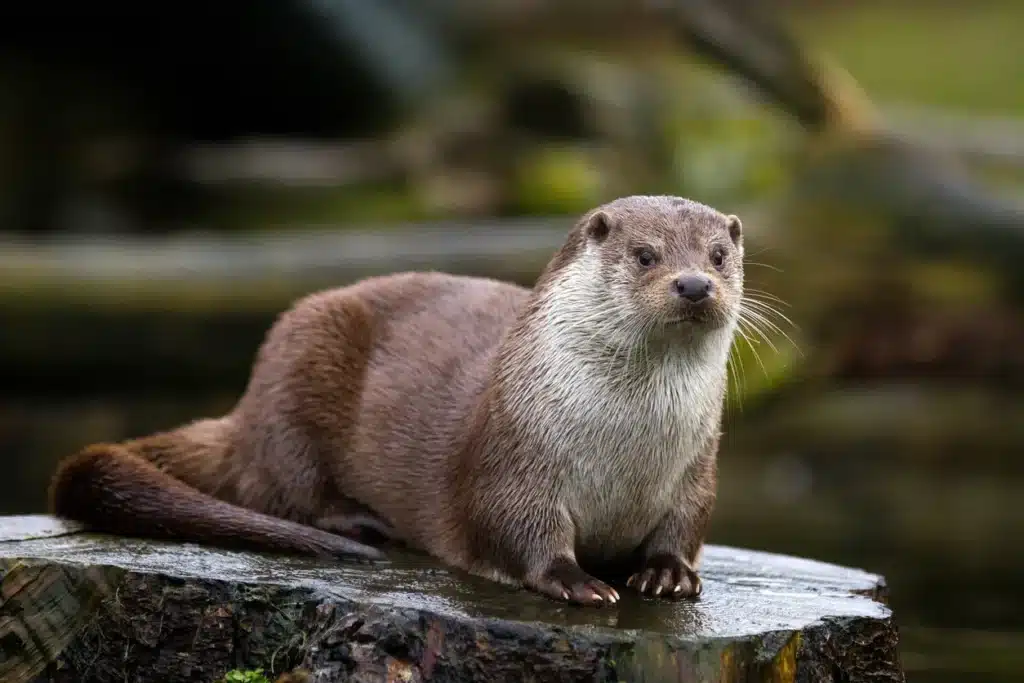
River Otters are semi-aquatic mammals known for their playful behavior and sleek, streamlined bodies.
They typically measure 66-107 cm (26-42 inches) in body length, with an additional 30-50 cm (12-20 inches) tail, and weigh between 5-14 kg (11-31 lbs).
Their fur is dense and water-repellent, usually dark brown. They have webbed feet, a long, tapered tail, and small ears and nostrils that can be closed underwater.
• Region of Habitat: North America, Europe, Asia, and parts of North Africa
• Scientific Name: Lontra canadensis (North American River Otter)
• Place of Origin: Various, depending on species
• Feeding Habits: Carnivorous, primarily eating fish, crayfish, and other aquatic animals
• What Sound They Make: Various vocalizations, including chirps, whistles, and growls
Fun Facts: River Otters can hold their breath for up to 8 minutes underwater. Their extremely sensitive whiskers help them detect prey in murky water.
Despite being excellent swimmers, young otters have to be taught to swim by their parents.
River Otters are known for their playful behavior, often seen sliding down muddy or snowy banks for what appears to be sheer enjoyment.
They play an important role in their ecosystems by controlling fish populations and are considered indicator species for the health of aquatic environments.
22. Roadrunner
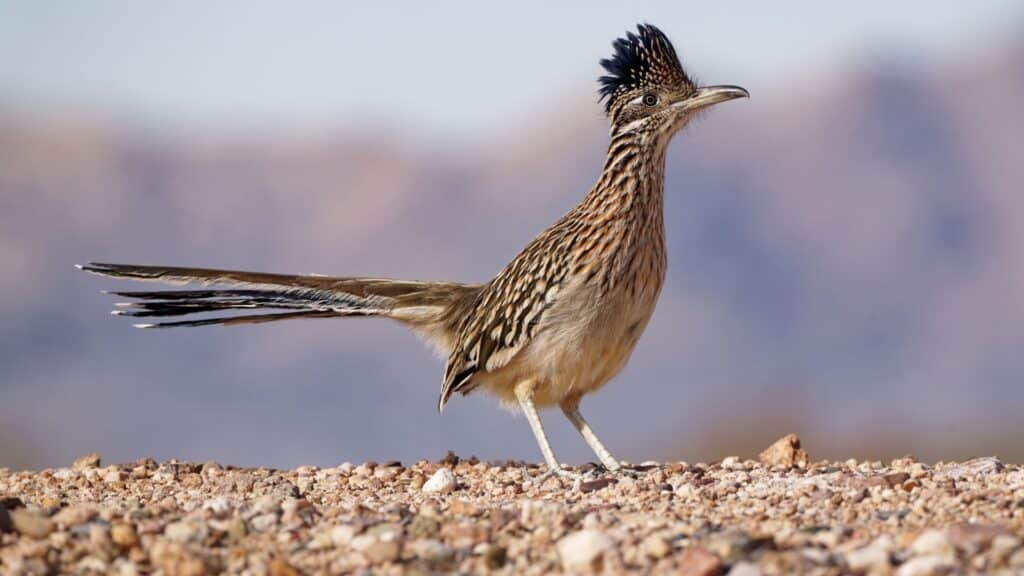
The Roadrunner is a fast-running ground cuckoo native to North and Central America. It typically measures 50-62 cm (20-24 inches) in length, including its long tail, and weighs between 220-340 grams (7.8-12 oz).
Their plumage is mottled brown and white, with a distinctive crest on their head and a long, sturdy beak.
Despite being capable of flight, they prefer to run, reaching speeds up to 32 km/h (20 mph).
• Region of Habitat: Southwestern United States and Mexico
• Scientific Name: Geococcyx californianus
• Place of Origin: North America
• Feeding Habits: Carnivorous, eating insects, small reptiles, and rodents
• What Sound They Make: Various vocalizations, including coos, whirrs, and clicking sounds
Fun Facts: Contrary to popular cartoons, roadrunners cannot outrun a coyote, which can reach up to 43 mph speeds.
However, they are fast enough to catch and eat rattlesnakes, which they bash against rocks to kill before swallowing whole.
Roadrunners have a unique X-shaped footprint, which ancient Native American tribes used as a sacred symbol to ward off evil.
These birds can survive without water, getting the moisture they need from their prey. Roadrunners are monogamous and may mate for life, with both parents sharing in nest building and chick rearing.
23. Robin
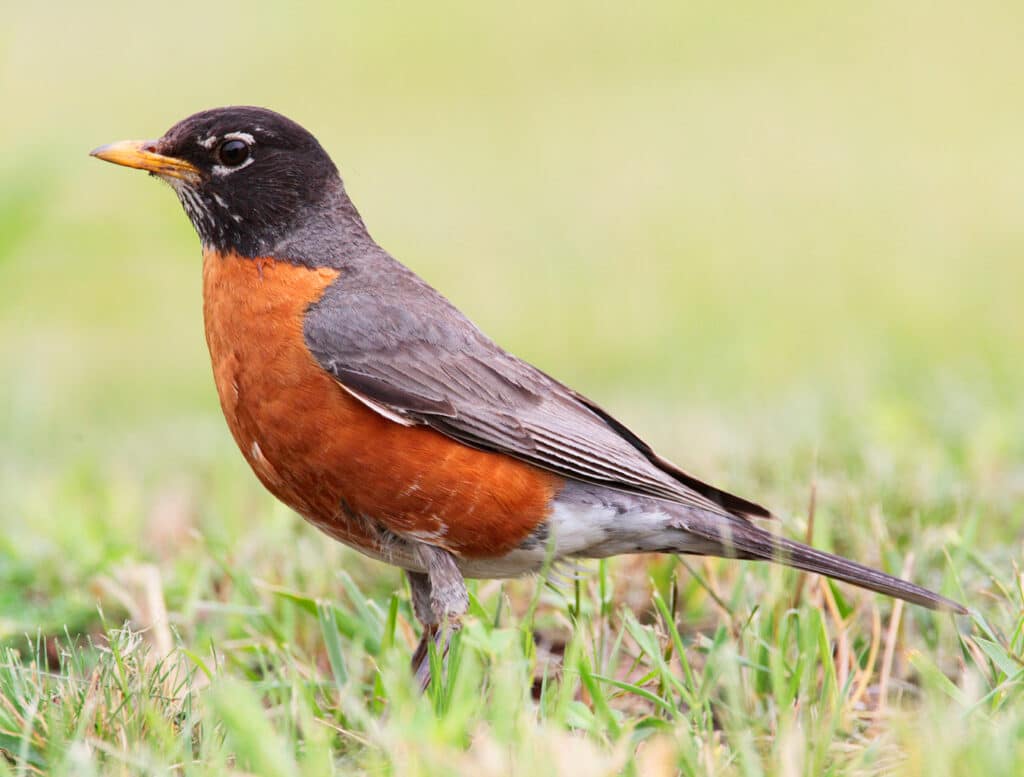
Robins are small passerine birds known for their orange-red breast. The American Robin typically measures 20-28 cm (8-11 inches) in length and weighs between 77-85 grams (2.7-3 oz).
The European Robin is smaller, measuring 12.5-14 cm (5-5.5 inches) and weighing 16-22 grams (0.6-0.8 oz).
Both species have a round body, long legs, and a thin beak. Their upperparts are usually brown or olive.
• Region of Habitat: North America (American Robin), Europe, North Africa, and Western Asia (European Robin)
• Scientific Name: Turdus migratorius (American Robin), Erithacus rubecula (European Robin)
• Place of Origin: North America and Eurasia, respectively
• Feeding Habits: Omnivorous, eating worms, insects, and berries
• What Sound They Make: Melodious whistling songs and sharp alarm calls
Fun Facts: American and European Robins are not closely related despite sharing a name. The American Robin is a thrush, while the European Robin is an Old World flycatcher.
American Robins are often considered a sign of spring, but many stay in their breeding range all year round.
Both species are known for their beautiful songs, which they sing even during winter when most other birds are silent.
24. Rock Hyrax
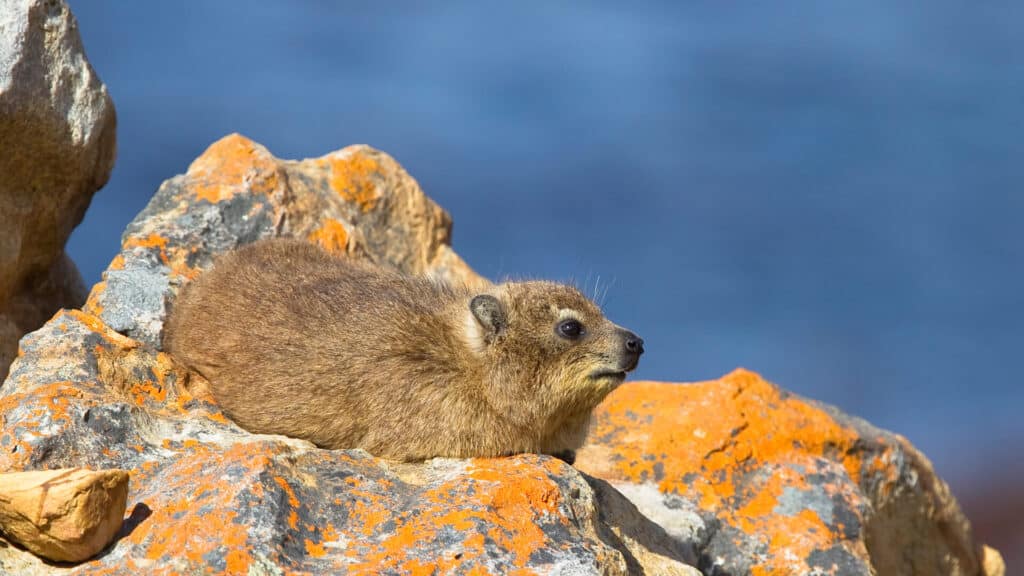
The Rock Hyrax, also known as the rock badger or dassie, is a small, terrestrial mammal native to Africa and the Middle East.
They typically measure 30-54 cm (12-21 inches) in length and weigh between 2-5 kg (4.4-11 lbs).
Despite their small size and rodent-like appearance, they are more closely related to elephants and manatees. They have a stocky build, short legs, and a small tail often hidden in their thick, brownish fur.
• Region of Habitat: Africa and the Middle East
• Scientific Name: Procavia capensis
• Place of Origin: Africa
• Feeding Habits: Herbivorous, eating a wide variety of plants
• What Sound They Make: Various vocalizations, including grunts, whistles, and trills
Fun Facts: Rock Hyraxes have excellent eyesight and complex social structures. They often live in colonies of up to 50 individuals.
They have a unique thermoregulation system, often basking in the sun to warm up and huddling together to retain heat.
Despite their small size, female hyraxes have an unusually long gestation period of around 7-8 months.
Interestingly, they are one of the few mammals that cannot produce their vitamin C and must obtain it from their diet.
25. Rock Python
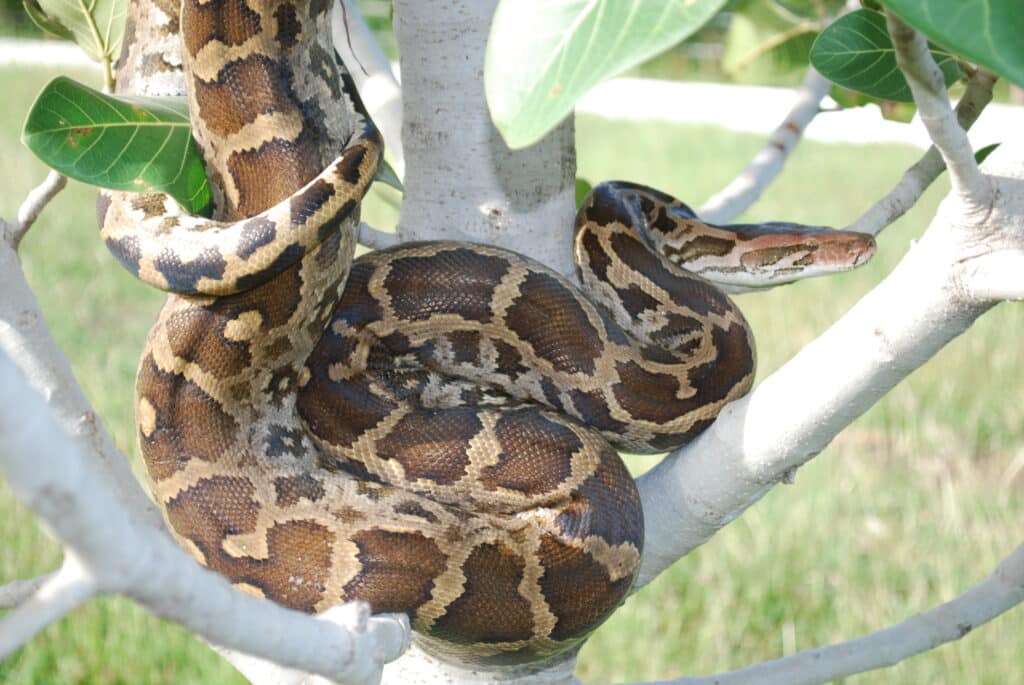
The Rock Python, also known as the African Rock Python, is one of the largest snake species in Africa.
They typically grow to lengths of 3-4.5 meters (10-15 feet), with some exceptional specimens reaching up to 6 meters (20 feet).
They can weigh 44-55 kg (97-121 lbs), with the largest recorded specimen weighing 91 kg (200 lbs).
Their bodies are thick and muscular, covered in smooth scales with irregular dark brown blotches on a lighter background.
• Region of Habitat: Sub-Saharan Africa
• Scientific Name: Python sebae
• Place of Origin: Africa
• Feeding Habits: Carnivorous, eating mammals, birds, and reptiles
• What Sound They Make: Generally silent, may hiss when threatened
Fun Facts: Rock Pythons are excellent swimmers who can stay submerged for 30 minutes. They are known for their ability to consume large prey, sometimes eating animals as big as antelopes.
Rock Pythons use heat-sensing pits along their jaws to detect warm-blooded prey. They are oviparous, with females laying up to 100 eggs simultaneously.
Unlike many snakes, female Rock Pythons will coil around their eggs to incubate and protect them from predators. In some African cultures, these pythons are considered sacred and are protected.
26. Rockhopper Penguin
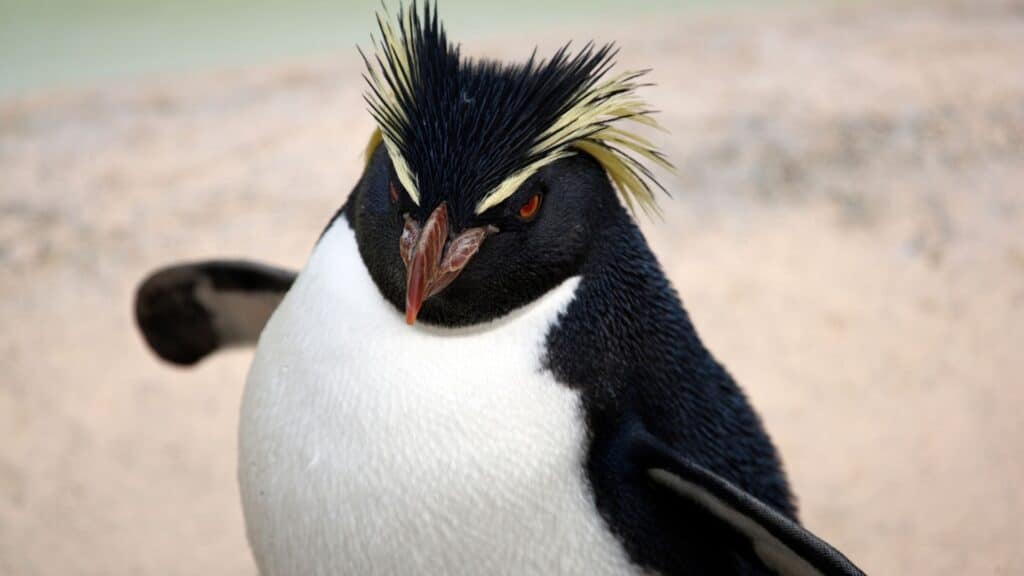
Rockhopper Penguins are small, crested penguins known for their distinctive appearance and ability to hop on rocks.
They typically stand about 40-45 cm (16-18 inches) tall and weigh between 2-4 kg (4.4-8.8 lbs).
They have a black back, white belly, and a distinctive yellow crest on their head that resembles eyebrows. Their eyes are red and have a short, thick red bill. Their feet are pink with black soles.
• Region of Habitat: Sub-Antarctic islands in the southern Atlantic, Indian, and Pacific Oceans
• Scientific Name: Eudyptes chrysocome
• Place of Origin: Southern Hemisphere oceans
• Feeding Habits: Carnivorous, primarily eating krill, small fish, and squid
• What Sound They Make: Loud, harsh squawks and braying sounds
Fun Facts: Rockhopper Penguins get their name from their habit of hopping from rock to rock instead of sliding on their bellies like many other penguin species.
Rockhopper penguins are excellent swimmers who can descend up to 100 meters (330 feet) deep for food. There are three species of Rockhopper Penguins: southern, northern, and eastern.
These penguins are monogamous and return to the same nesting site each year. Despite their small size, they are known for their aggressive behavior, especially during breeding season.
27. Roe Deer
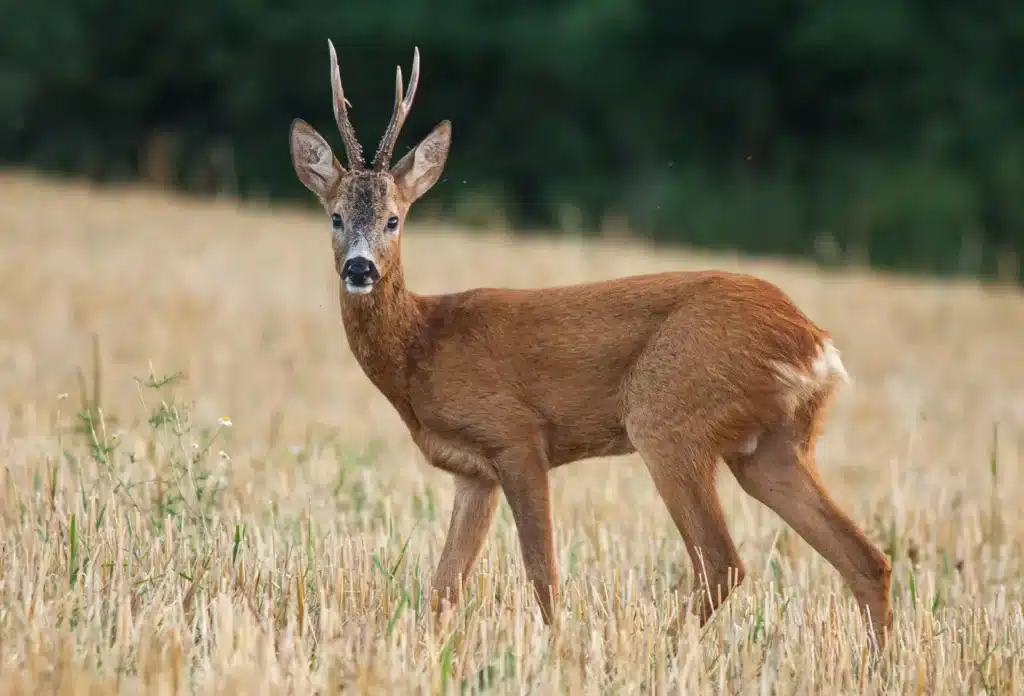
Roe Deer are small to medium-sized deer native to Europe. They typically measure 95-135 cm (37-53 inches) in body length, stand 60-75 cm (24-30 inches) at the shoulder, and weigh between 15-30 kg (33-66 lbs).
Their coat is reddish-brown in summer, turning grayish-brown in winter. Males (bucks) have short, usually three-pointed antlers shed annually. They have large ears, a white rump, and no visible tail.
• Region of Habitat: Europe and parts of Asia
• Scientific Name: Capreolus capreolus
• Place of Origin: Eurasia
• Feeding Habits: Herbivorous, eating leaves, berries, and young shoots
• What Sound They Make: Barks when alarmed, and bucks make a dog-like yelping sound during mating season
Fun Facts: Roe Deer are known for their unique reproductive cycle. After mating in summer, the fertilized egg doesn’t implant immediately but remains dormant for several months, a process called delayed implantation.
This ensures that fawns are born in spring when conditions are most favorable. Roe Deer are excellent jumpers and can clear obstacles up to 2 meters (6.6 feet) high.
They are primarily solitary or found in small family groups, unlike many other deer species that form large herds. In medieval times, roe deer were often featured in art and literature as symbols of purity and innocence.
28. Rooster
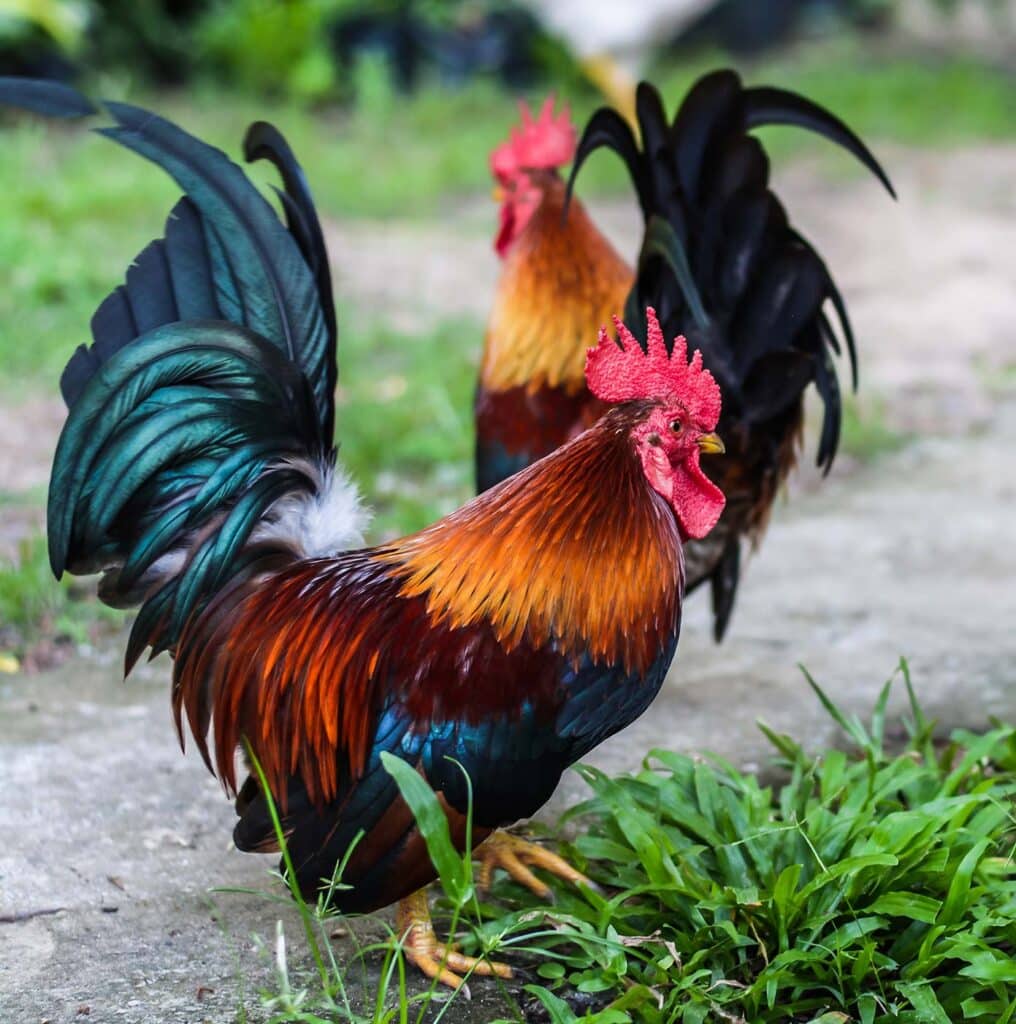
Roosters are adult male chickens known for their distinctive crowing and colorful feathers.
They typically stand about 50-70 cm (20-28 inches) tall and weigh between 2.5-5 kg (5.5-11 lbs), which can vary greatly depending on the breed.
Roosters are characterized by their vibrant feathers, large combs and wattles, and sharp spurs on their legs. They often have long, arching tail feathers and a more upright stance than hens.
• Region of Habitat: Worldwide (domesticated)
• Scientific Name: Gallus gallus domesticus
• Place of Origin: Southeast Asia (wild ancestor)
• Feeding Habits: Omnivorous, eating seeds, insects, and small animals
• What Sound They Make: Loud crowing, as well as clucks and other vocalizations
Fun Facts: Roosters are known for crowing at dawn, but they crow throughout the day and can even crow at night if disturbed.
The rooster’s comb is not just for show – it helps regulate their body temperature. Roosters perform a courtship dance called ‘tidbitting,’ where they make sounds and move their head up and down while picking up and dropping food to attract hens.
Contrary to popular belief, roosters can fly, although not for long distances or durations.
29. Rottweiler

Rottweilers are large, powerful dogs known for their strength and guardian instincts. They typically stand 56-69 cm (22-27 inches) at the shoulder and weigh between 35-60 kg (77-132 lbs), with males larger than females.
Rottweilers have a short, dense black coat with distinct tan markings on their cheeks, muzzle, chest, and legs. They have a broad head, strong jaws, and a muscular, mighty body.
• Region of Habitat: Worldwide (domesticated)
• Scientific Name: Canis lupus familiaris
• Place of Origin: Germany
• Feeding Habits: Carnivorous, typically fed commercial dog food
• What Sound They Make: Deep, resonant barks and various vocalizations
Fun Facts: Rottweilers are descendants of the Molossus, a mastiff-type dog used by the Romans.
They were originally bred to drive cattle and pull carts for butchers, so they’re sometimes called “Butcher’s Dogs.”
Despite their intimidating appearance, well-trained Rottweilers are known for their calm and confident conduct.
They are highly intelligent and trainable, often used in police work, search and rescue, and as therapy dogs.
Rottweilers have a strong prey drive and tend to be protective of their families, making early socialization crucial. They are ranked the 8th most popular dog breed in the United States.
30. Royal Penguin
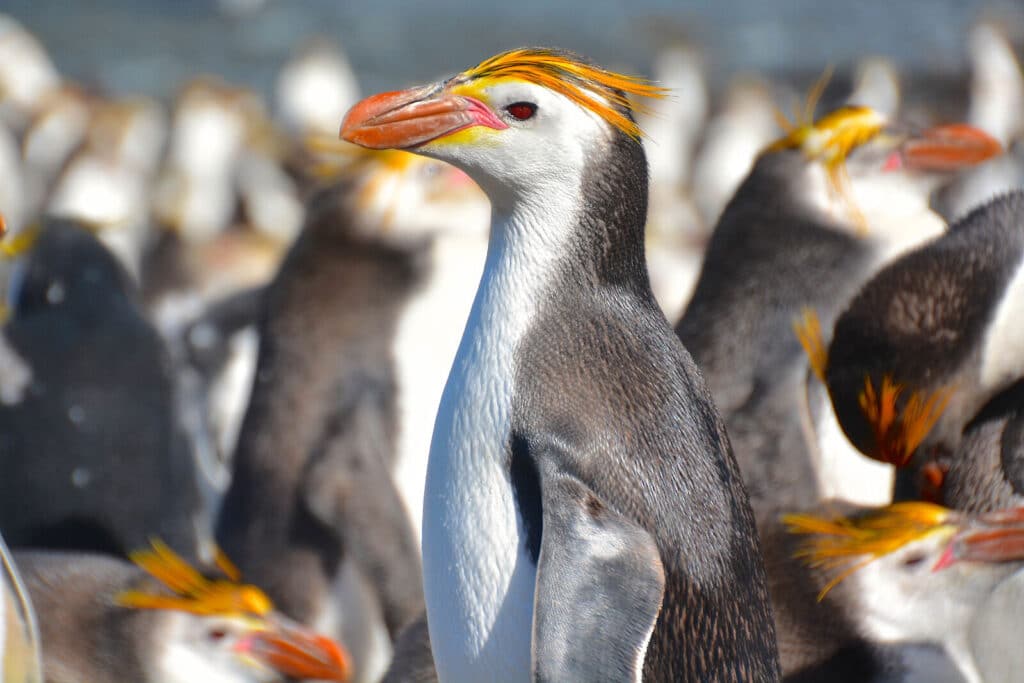
Royal Penguins are medium-sized penguins known for their distinctive yellow crest. They typically stand about 65-75 cm (26-30 inches) tall and weigh between 4-8 kg (9-18 lbs).
They have a black back, white belly, and a thick, orange-pink bill. Their most notable feature is the long yellow crest that extends from their bill to the back of their head, giving them a “royal” appearance. Their eyes are red, and they have pink feet.
• Region of Habitat: Sub-Antarctic islands, primarily Macquarie Island
• Scientific Name: Eudyptes schlegeli
• Place of Origin: Southern Pacific Ocean
• Feeding Habits: Carnivorous, primarily eating krill, small fish, and squid
• What Sound They Make: Loud, trumpeting calls, especially during the breeding season
Fun Facts: Royal Penguins are sometimes considered a subspecies of the Macaroni Penguin due to their similar appearance.
They are excellent swimmers and can plunge to depths of up to 150 meters (492 feet) for food.
Royal Penguins form large, dense colonies of up to 500,000 pairs during breeding season. They are monogamous and usually return to the same nesting site each year.
Interestingly, Royal Penguins have a unique breeding strategy. They lay two eggs but typically only raise one chick, with the first egg being much smaller and usually not surviving.
Conclusion
As we conclude our exploration of animals with R names, it’s clear that the natural world is filled with an astonishing variety of creatures.
Each animal plays a unique role in its ecosystem, from the powerful rhinoceros to the tiny rock hyrax.
This journey has taken us across diverse habitats, from the African savannas to the Arctic tundra, showcasing the adaptability and resilience of these R-named species.
What’s next? Consider researching conservation efforts for endangered animals like the red wolf or the rhinoceros.
You could also explore ways to support wildlife in your local area. Remember, regardless of its name, every animal contributes to the delicate balance of our planet’s biodiversity.
Let’s continue to learn about and appreciate these fascinating creatures, ensuring their survival for future generations.


